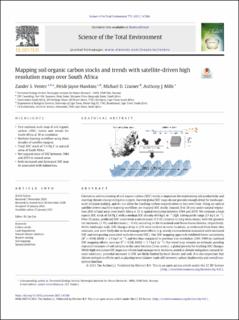| dc.contributor.author | Venter, Zander | |
| dc.contributor.author | Hawkins, Heidi-Jayne | |
| dc.contributor.author | Cramer, Michael D. | |
| dc.contributor.author | Mills, Anthony J. | |
| dc.coverage.spatial | South Africa | en_US |
| dc.date.accessioned | 2022-03-23T12:03:55Z | |
| dc.date.available | 2022-03-23T12:03:55Z | |
| dc.date.created | 2021-05-19T14:24:02Z | |
| dc.date.issued | 2021 | |
| dc.identifier.citation | Science of the Total Environment. 2021, 771 1-14. | en_US |
| dc.identifier.issn | 0048-9697 | |
| dc.identifier.uri | https://hdl.handle.net/11250/2987094 | |
| dc.description.abstract | Estimation and monitoring of soil organic carbon (SOC) stocks is important for maintaining soil productivity and meeting climate change mitigation targets. Current global SOC maps do not provide enough detail for landscape- scale decision making, and do not allow for tracking carbon sequestration or loss over time. Using an optical satellite-driven machine learning workflow, we mapped SOC stocks (topsoil; 0 to 30 cm) under natural vegeta- tion (86% of land area) over South Africa at 30 m spatial resolution between 1984 and 2019. We estimate a total topsoil SOC stock of 5.6 Pg C with a median SOC density of 6 kg C m−2 (IQR: interquartile range 2.9 kg C m−2). Over 35 years, predicted SOC underwent a net increase of 0.3% (relative to long-term mean) with the greatest net increases (1.7%) and decreases (−0.6%) occurring in the Grassland and Nama Karoo biomes, respectively. At the landscape scale, SOC changes of up to 25% were evident in some locations, as evidenced from fence-line contrasts, and were likely due to local management effects (e.g. woody encroachment associated with increased SOC and overgrazing associated with decreased SOC). Our SOC mapping approach exhibited lower uncertainty (R2 = 0.64; RMSE = 2.5 kg C m−2) and less bias compared to previous low-resolution (250–1000 m) national SOC mapping efforts (average R2 = 0.24; RMSE = 3.7 kg C m−2). Our trend map remains an estimate, pending repeated measures of soil samples in the same location (time-series); a global priority for tracking SOC changes. While high resolution SOC maps can inform land management decisions aimed at climate mitigation (natural cli- mate solutions), potential increases in SOC are likely limited by local climate and soils. It is also important that climate mitigation efforts such as planting trees balance trade-offs between car Carbon stocks Land degradation Natural climate solutions Remote sensing Soil mapping Spatial predictionbon, biodiversity and overall eco- system function | en_US |
| dc.language.iso | eng | en_US |
| dc.rights | Navngivelse 4.0 Internasjonal | * |
| dc.rights.uri | http://creativecommons.org/licenses/by/4.0/deed.no | * |
| dc.subject | Carbon stocks | en_US |
| dc.subject | Land degradation | en_US |
| dc.subject | Natural climate solutions | en_US |
| dc.subject | Remote sensing | en_US |
| dc.subject | Soil mapping | en_US |
| dc.subject | Spatial prediction | en_US |
| dc.title | Mapping soil organic carbon stocks and trends with satellite-driven high resolution maps over South Africa | en_US |
| dc.type | Peer reviewed | en_US |
| dc.type | Journal article | en_US |
| dc.description.version | publishedVersion | en_US |
| dc.rights.holder | © 2021 The Author(s) | en_US |
| dc.subject.nsi | VDP::Samfunnsvitenskap: 200 | en_US |
| dc.subject.nsi | VDP::Social sciences: 200 | en_US |
| dc.source.pagenumber | 1-14 | en_US |
| dc.source.volume | 771 | en_US |
| dc.source.journal | Science of the Total Environment | en_US |
| dc.identifier.doi | 10.1016/j.scitotenv.2021.145384 | |
| dc.identifier.cristin | 1910797 | |
| dc.relation.project | Andre: National Research Foundation | en_US |
| dc.relation.project | Andre: Patterson Foundation | en_US |
| cristin.ispublished | true | |
| cristin.fulltext | original | |
| cristin.qualitycode | 2 | |

